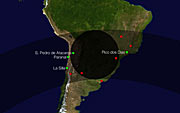Press Release
Dwarf Planet Makemake Lacks Atmosphere
Distant frigid world reveals its secrets for the first time
21 November 2012
Astronomers have used three telescopes at ESO’s observatories in Chile to observe the dwarf planet Makemake as it drifted in front of a distant star and blocked its light. The new observations have allowed them to check for the first time whether Makemake is surrounded by an atmosphere. This chilly world has an orbit lying in the outer Solar System and was expected to have an atmosphere like Pluto (eso0908), but this is now shown not to be the case. The scientists also measured Makemake’s density for the first time. The new results are to be published in the 22 November issue of the journal Nature.
Dwarf planet Makemake [1] is about two thirds of the size of Pluto, and travels around the Sun in a distant path that lies beyond that of Pluto but closer to the Sun than Eris, the most massive known dwarf planet in the Solar System (eso1142). Previous observations of chilly Makemake have shown it to be similar to its fellow dwarf planets, leading some astronomers to expect its atmosphere, if present, to be similar to that of Pluto. However, the new study now shows that, like Eris, Makemake is not surrounded by a significant atmosphere.
The team, led by José Luis Ortiz (Instituto de Astrofísica de Andalucía, CSIC, Spain), combined multiple observations using three telescopes at ESO’s La Silla and Paranal observing sites in Chile — the Very Large Telescope (VLT), New Technology Telescope (NTT), and TRAPPIST (TRAnsiting Planets and PlanetesImals Small Telescope) — with data from other small telescopes in South America [2], to look at Makemake as it passed in front of a distant star [3].
“As Makemake passed in front of the star and blocked it out, the star disappeared and reappeared very abruptly, rather than fading and brightening gradually. This means that the little dwarf planet has no significant atmosphere,” says José Luis Ortiz. “It was thought that Makemake had a good chance of having developed an atmosphere — that it has no sign of one at all shows just how much we have yet to learn about these mysterious bodies. Finding out about Makemake’s properties for the first time is a big step forward in our study of the select club of icy dwarf planets.”
Makemake’s lack of moons and its great distance from us make it difficult to study [4], and what little we do know about the body is only approximate. The team’s new observations add much more detail to our view of Makemake — determining its size more accurately, putting constraints on a possible atmosphere and estimating the dwarf planet’s density for the first time. They have also allowed the astronomers to measure how much of the Sun’s light Makemake’s surface reflects — its albedo [5]. Makemake’s albedo, at about 0.77, is comparable to that of dirty snow, higher than that of Pluto, but lower than that of Eris.
It was only possible to observe Makemake in such detail because it passed in front of a star — an event known as a stellar occultation. These rare opportunities are allowing astronomers for the first time to find out a great deal about the sometimes tenuous and delicate atmospheres around these distant, but important, members of the Solar System, and providing very accurate information about their other properties.
Occultations are particularly uncommon in the case of Makemake, because it moves in an area of the sky with relatively few stars. Accurately predicting and detecting these rare events is extremely difficult and the successful observation by a coordinated observing team, scattered at many sites across South America, ranks as a major achievement.
“Pluto, Eris and Makemake are among the larger examples of the numerous icy bodies orbiting far away from our Sun,” says José Luis Ortiz. “Our new observations have greatly improved our knowledge of one of the biggest, Makemake — we will be able to use this information as we explore the intriguing objects in this region of space further.”
Notes
[1] Makemake was initially known as 2005 FY9. It was discovered a few days after Easter in March 2005, earning it the informal nickname of Easterbunny. In July 2008 it was given the official name of Makemake. Makemake is the creator of humanity and god of fertility in the myths of the native people of Easter Island.
Makemake is one of five dwarf planets so far recognised by the International Astronomical Union. The others are Ceres, Pluto, Haumea and Eris. Further information about dwarf planets and planets is available from the International Astronomical Union.
[2] Another of the telescopes used in this observing campaign was an 0.84-metre telescope installed by the Católica del Norte University of Chile. This telescope is sited on Cerro Armazones, the future site of the European Extremely Large Telescope (E-ELT).
[3] Makemake passed in front of faint star NOMAD 1181-0235723 (where NOMAD refers to the Naval Observatory Merged Astrometric Dataset) on 23 April 2011. The team observed this event using seven different telescopes across Brazil and Chile. The event only lasted about one minute, so the astronomers took advantage of a specialised high-speed camera known as ULTRACAM (eso0520) and a high-speed infrared imager named ISAAC to capture the event.
[4] In the case of objects that are orbited by one or more moons the motions of the moons can be used to deduce the mass of the object. This was not possible in the case of Makemake.
[5] The dwarf planet was calculated to have a geometrical albedo of 0.77 ± 0.03, greater than Pluto’s, but smaller than that of Eris. An albedo of 1 represents a perfectly reflecting body, and 0 a black surface that does not reflect at all. The observations, together with previous results, indicate that Makemake has a density of 1.7 ± 0.3 grams per cubic centimetre, which in turn allowed the team to infer the shape and appearance of an oblate spheroid — a sphere flattened slightly at both poles — with axes of 1430 ± 9 kilometres and 1502 ± 45 kilometres. Makemake shows no global Pluto-like atmosphere at a level of one thousandth of that of Pluto's atmosphere. However, it may have an atmosphere that only covers part of the surface. Such a local atmosphere, which is possible in theory, is not excluded by the observations.
More information
This research was presented in a paper “Albedo and atmospheric constraints of dwarf planet Makemake from a stellar occultation” to appear in the 22 November 2012 issue of the journal Nature.
The team is composed of J. L. Ortiz (Instituto de Astrofísica de Andalucía, CSIC, Spain), B. Sicardy (Observatoire de Paris; CNRS; Université Pierre et Marie Curie; Université Paris Diderot; Institut Universitaire de France), F. Braga-Ribas (Observatoire de Paris, CNRS, France; Observatório Nacional/MCTI, Brazil), A. Alvarez-Candal (European Southern Observatory, Chile; Instituto de Astrofísica de Andalucía, CSIC, Spain), E. Lellouch (Observatoire de Paris, CNRS, France), et al.
For the full list of authors and affiliations please refer to the Nature paper.
The year 2012 marks the 50th anniversary of the founding of the European Southern Observatory (ESO). ESO is the foremost intergovernmental astronomy organisation in Europe and the world’s most productive ground-based astronomical observatory by far. It is supported by 15 countries: Austria, Belgium, Brazil, Czechia, Denmark, France, Finland, Germany, Italy, the Netherlands, Portugal, Spain, Sweden, Switzerland and the United Kingdom. ESO carries out an ambitious programme focused on the design, construction and operation of powerful ground-based observing facilities enabling astronomers to make important scientific discoveries. ESO also plays a leading role in promoting and organising cooperation in astronomical research. ESO operates three unique world-class observing sites in Chile: La Silla, Paranal and Chajnantor. At Paranal, ESO operates the Very Large Telescope, the world’s most advanced visible-light astronomical observatory and two survey telescopes. VISTA works in the infrared and is the world’s largest survey telescope and the VLT Survey Telescope is the largest telescope designed to exclusively survey the skies in visible light. ESO is the European partner of a revolutionary astronomical telescope ALMA, the largest astronomical project in existence. ESO is currently planning the 39-metre European Extremely Large optical/near-infrared Telescope, the E-ELT, which will become “the world’s biggest eye on the sky”.
Links
Contacts
José Luis Ortiz
Instituto de Astrofísica de Andalucía, CSIC
Granada, Spain
Tel: +34 958 121 311
Cell: +34 622 233 836
Email: ortiz@iaa.es
Bruno Sicardy
Observatoire de Paris
Paris, France
Tel: +33 6 19 41 26 15
Email: bruno.sicardy@obspm.fr
Noemi Pinilla-Alonso
Earth and Planetary Sciences Department, University of Tennessee
Knoxville, USA
Tel: +1 865 974 2699
Email: npinilla@seti.org
Emmanuel Jehin
Institut d'Astrophysique de I'Université de Liège
Liège, Belgium
Tel: +32 4 3669726
Email: ejehin@ulg.ac.be
Richard Hook
ESO, La Silla, Paranal, E-ELT & Survey Telescopes Press Officer
Garching bei München, Germany
Tel: +49 89 3200 6655
Cell: +49 151 1537 3591
Email: rhook@eso.org
About the Release
| Release No.: | eso1246 |
| Name: | Makemake |
| Type: | Solar System : Interplanetary Body : Dwarf planet |
| Facility: | New Technology Telescope, TRAnsiting Planets and PlanetesImals Small Telescope–South, Very Large Telescope |
| Instruments: | ISAAC |
| Science data: | 2012Natur.491..566O |




